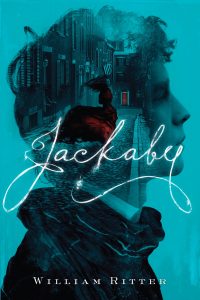 Jackaby
Jackaby
I’ve seen this series described as “Sherlock meets Doctor Who,” and that is pretty apt. It’s January 1892 and our plucky British narrator, Abigail Rook, has just arrived in New England and needs employment. No one is hiring except for the eccentric investigator, R. F. Jackaby, who is looking for a new assistant since his previous one is “currently waterfowl.” Jackaby’s physical description is evocative of Benedict Cumberbatch in character as Sherlock, and he’s occasionally tactless, but aside from one early demonstration, he doesn’t do much in the way of deduction. Instead, he’s more like The Doctor—a kooky, scarf-wearing fellow who dashes about warning townspeople of supernatural threats while they regard him as “a crackpot imbecile.” Abigail is, of course, the companion—a clever girl who has always longed for adventure but who has until now been denied it. Happily, there is no hint of romance between them.
In this first installment, Abigail and Jackaby work together to solve a series of murders afflicting a particular apartment building. Jackaby, of course, can tell the culprit is a creature of some sort while the policeman in charge scoffs at this assertion and, at one point, locks Abigail and Jackaby up for impeding his investigation. Although I liked the characters—especially Jenny Cavanaugh, the ghostly resident of Jackaby’s headquarters—the mystery portion of the book was sadly predictable. “Obvious culprit is obvious,” I wrote in my notes, and though I didn’t work out what sort of creature was to blame, another character’s bestial secret was no surprise.
Still, I did enjoy Jackaby and like the characters and tone well enough to continue. I do hope the next mystery is a little less transparent, though.
 “The Map”
“The Map”
This short story takes place on Abigail’s birthday. She’s been quite clear about not wanting a fuss, but Jackaby is determined that they will have an adventure. Their first stop is a magical market, which she doesn’t enjoy much, to Jackaby’s disappointment. While there, however, they pick up a treasure map and proceed to complete a series of challenges in search of the treasure buried by the notorious rogue, the Bold Deceiver.
“The Map” may not be an essential piece of reading, but it was enjoyable nonetheless. I especially liked the challenge in which they must get past the enormous hare guarding a castle—that one was sad and funny simultaneously. I also like that they’re not 100% successful with all the tasks, since centuries have passed since they were set up. On the whole, it’s worth checking out.
 Beastly Bones
Beastly Bones
It’s now the spring of 1892 and Jackaby and Abigail have been sent to the nearby town of Gad’s Valley to investigate thefts from a paleontological dig site. Abigail is mad for fossils, so is very excited about this prospect, while Jackaby must be convinced it’s worth their time. Another benefit is that Abigail gets to spend more time with Charlie the handsome policeman, for whom she has feelings, though she’s unsure what to do about him. Jenny the ghost has advised her to go for it and make the first move while Nelly Fuller, intrepid lady reporter, chastises her for thinking about love. “Do you want to be safe and happy or do you want to be great?”
As I had hoped, the mystery in Beastly Bones is a definite improvement over the first book; despite being a fine example of Chekhov’s Gun, its multiple layers made for a more complex case. Mostly, however, I liked that one aspect of it remains unsolved. Even though this series has Sherlockian elements, it hadn’t occurred to me that there’d be a Moriarty equivalent, but it looks like there is!
Still, the characters remain the main draw. Jackaby can be brash and insulting, but he doesn’t talk down to Abigail or treat her like a kid. I enjoyed his aversion to hearing about her romantic problems, and his awkward attempts to be sweet. “Buck up; you’re dreadful company when you’re melancholy.” Abigail continues to be resourceful and likable. And though there wasn’t much of Jenny, the ending finds her enlisting Jackaby to delve into her own murder. I’m very much looking forward to it!
 Ghostly Echoes
Ghostly Echoes
I’d really been looking forward to Ghostly Echoes and the truth behind Jenny’s murder, but it wasn’t exactly what I’d been hoping for.
True, Jenny’s murder is solved, but there is practically zero exploration of the person she was when she was alive. The plot is more about the evil council responsible (turns out that Moriarty-seeming character from previous books was only stirring things up to keep Jackaby busy so this group of dark fae could keep an eye on him) and the looming threat to mankind. Jenny did grow tremendously in both confidence and ability, and had a few genuinely badass moments in which she got to save her friends. I also appreciated her realization that she is more than a mere echo of the girl who died, but has her own thoughts and feelings. “I’m my own somebody.” I liked all of that, but I still wish she’d been the focus throughout instead of only in places.
Too, there’s not really much Jackaby, either. Yes, we learn about his childhood friend who was the Seer before him and how the council was after her too, but he just seems so… deflated. I guess it’s reasonable for him to be subdued given the case and its implications—he was worried that closure for Jenny might mean she’d move on—but I missed the humor he used to bring to situations. I reckon there shan’t be much of that in the next volume, either, in which our heroes face off against the bad guys and attempt to save the world.
 The Dire King
The Dire King
The final entry in the Jackaby series wasn’t bad but, like the previous installment, certain character moments that I really wanted to see play out were completely glossed over.
Jackaby and company are trying to prevent the Dire King from destroying the veil that separates the Annwn and our world. This involves locating a particular magical artifact, attempting to destroy a diabolical machine, clashing armies, and lots and lots of fairies and magical creatures. I cannot possibly express how little interest I have in lots and lots of fairies and magical creatures.
There was at least more Jackaby here, and a somewhat warmer one, which I appreciated. I just wish there was much more about him and Jenny. She’s finally able to overcome her inability to touch him when his life is on the line, and there’s the suggestion that they’re going to live happily ever after once the crisis has been averted, but man, I really wish we’d gotten a scene where he pours his heart out and she scolds him for taking so long while also crying happily. Similarly, while I like where Abigail ultimately ends up, the very end is briefly pretty great but then it’s just… over.
I know cheesy epilogues get maligned pretty often, but in this case I would’ve appreciated one!

 Daytime Shooting Star, Vol. 1 by Mika Yamamori
Daytime Shooting Star, Vol. 1 by Mika Yamamori Komi Can’t Communicate, Vol. 1 by Tomohito Oda
Komi Can’t Communicate, Vol. 1 by Tomohito Oda Snow White with the Red Hair, Vol. 1 by Sorata Akiduki
Snow White with the Red Hair, Vol. 1 by Sorata Akiduki That Blue Sky Feeling, Vols. 1-2 by Okura and Coma Hashii
That Blue Sky Feeling, Vols. 1-2 by Okura and Coma Hashii Will I Be Single Forever? by Mari Okazaki
Will I Be Single Forever? by Mari Okazaki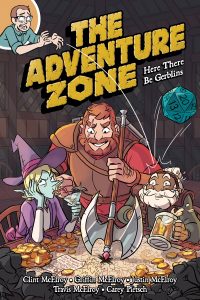 I’m a newcomer to The Adventure Zone podcast (only 24 episodes in at this point, so no spoilers, please!) but quickly fell deeply in love with it. My timing was good, actually, because it just about coincided with the release of the graphic novel based on the first arc of the podcast’s first season (also known as the Balance campaign). Initially, I thought I’d simply enjoy the graphic novel instead of reviewing it because the podcast is so important to me. It’s been a really tough year and The Adventure Zone made me laugh and gave me something new to feel enthusiastic about, and for that I will be forever grateful. Happily, however, the print adaptation is just so damned good that I find I have to talk about it!
I’m a newcomer to The Adventure Zone podcast (only 24 episodes in at this point, so no spoilers, please!) but quickly fell deeply in love with it. My timing was good, actually, because it just about coincided with the release of the graphic novel based on the first arc of the podcast’s first season (also known as the Balance campaign). Initially, I thought I’d simply enjoy the graphic novel instead of reviewing it because the podcast is so important to me. It’s been a really tough year and The Adventure Zone made me laugh and gave me something new to feel enthusiastic about, and for that I will be forever grateful. Happily, however, the print adaptation is just so damned good that I find I have to talk about it!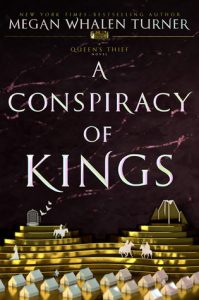 A Conspiracy of Kings
A Conspiracy of Kings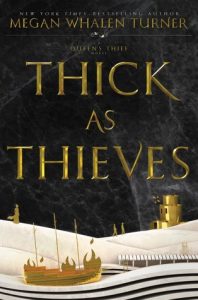 Thick as Thieves
Thick as Thieves Makoto Kowata is a novice witch who, in the tradition of witches, has left home at the age of fifteen to become independent. Her parents are concerned about her safety, though, so she’s staying with relatives in Aomori, located in the Tohoko region where it’s easier to perform magic thanks to abundant wilderness and natural resources. Accompanying her is her familiar, a black cat named Chito who is indisputably my favorite character.
Makoto Kowata is a novice witch who, in the tradition of witches, has left home at the age of fifteen to become independent. Her parents are concerned about her safety, though, so she’s staying with relatives in Aomori, located in the Tohoko region where it’s easier to perform magic thanks to abundant wilderness and natural resources. Accompanying her is her familiar, a black cat named Chito who is indisputably my favorite character. Harry Potter and the Cursed Child joins
Harry Potter and the Cursed Child joins 


 In the kingdom of Kohka, kindly King Il adores his only child, Princess Yona, and throws a celebration for her sixteenth birthday. Red-haired Yona is primarily preoccupied with getting her cousin, Su-Won, to see her as a woman. After the festivities, she decides to go tell her father that she simply must be allowed to marry Su-Won, only to walk in on her beloved running her father through with a sword. The palace guards are in on the treachery, and ready to comply with Su-Won’s order to dispatch the witness, but Yona is saved by her trusty personal guard, Hak, and the two of them manage to escape.
In the kingdom of Kohka, kindly King Il adores his only child, Princess Yona, and throws a celebration for her sixteenth birthday. Red-haired Yona is primarily preoccupied with getting her cousin, Su-Won, to see her as a woman. After the festivities, she decides to go tell her father that she simply must be allowed to marry Su-Won, only to walk in on her beloved running her father through with a sword. The palace guards are in on the treachery, and ready to comply with Su-Won’s order to dispatch the witness, but Yona is saved by her trusty personal guard, Hak, and the two of them manage to escape. I’m interested in a couple of the villainous characters, too! Kang Tae-jun of the fire tribe has desired Yona for a long time, so his remorse at her apparent death is genuine, even if he’s an entitled jerk. He reminds me of Skip Beat!’s Sho, a little bit, and I have a strong desire to see him switch sides someday and become a better person. And then there’s Su-Won, who ends the volume believing that Yona’s dead and being crowned king even as he admits that he crushed his dearest friends underfoot to achieve it. That’s much more interesting than him being utterly evil, and I wonder if he was manipulated into believing King Il had murdered his father or if that’s actually true. Unfortunately, both of these guys are more interesting to me right now than Hak is. Hopefully that will change.
I’m interested in a couple of the villainous characters, too! Kang Tae-jun of the fire tribe has desired Yona for a long time, so his remorse at her apparent death is genuine, even if he’s an entitled jerk. He reminds me of Skip Beat!’s Sho, a little bit, and I have a strong desire to see him switch sides someday and become a better person. And then there’s Su-Won, who ends the volume believing that Yona’s dead and being crowned king even as he admits that he crushed his dearest friends underfoot to achieve it. That’s much more interesting than him being utterly evil, and I wonder if he was manipulated into believing King Il had murdered his father or if that’s actually true. Unfortunately, both of these guys are more interesting to me right now than Hak is. Hopefully that will change.

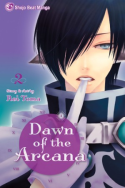



Recent Comments